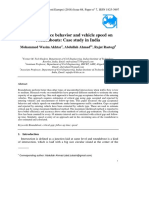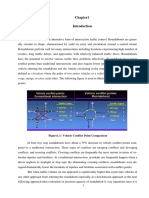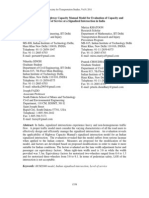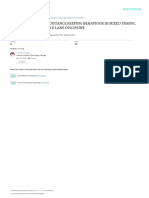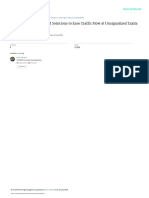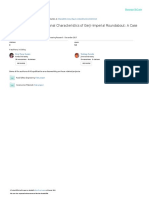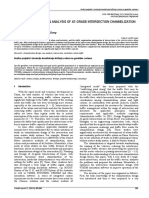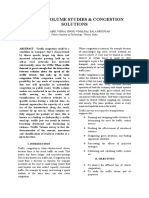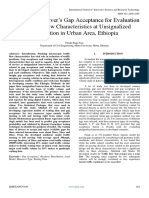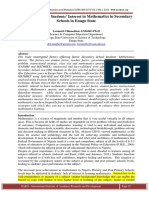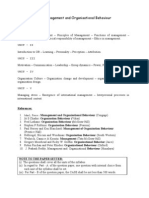Development of Delay Models For Roundabout With Heterogeneous Traffic Flow Condition
Development of Delay Models For Roundabout With Heterogeneous Traffic Flow Condition
Uploaded by
Reikja KhrhisCopyright:
Available Formats
Development of Delay Models For Roundabout With Heterogeneous Traffic Flow Condition
Development of Delay Models For Roundabout With Heterogeneous Traffic Flow Condition
Uploaded by
Reikja KhrhisOriginal Description:
Original Title
Copyright
Available Formats
Share this document
Did you find this document useful?
Is this content inappropriate?
Copyright:
Available Formats
Development of Delay Models For Roundabout With Heterogeneous Traffic Flow Condition
Development of Delay Models For Roundabout With Heterogeneous Traffic Flow Condition
Uploaded by
Reikja KhrhisCopyright:
Available Formats
Indian J.Sci.Res.
17(2): 46-57, 2018 ISSN: 0976-2876 (Print)
ISSN: 2250-0138(Online)
DEVELOPMENT OF DELAY MODELS FOR ROUNDABOUT WITH HETEROGENEOUS
TRAFFIC FLOW CONDITION
1
K Shashi Kumar, 2R Ramu,3Dr. R Srinivasa Kumar
1
Department of Civil Engineering, College of Engineering, Osmania University, Hyderabad
2
Department of Civil Engineering, SR Engineering college, Hasanparthi, Warangal
3
Department of Civil Engineering, University College of Engineering, Osmania University, Hyderabad
Abstract- The purpose of this research was to develop a model for estimating roundabout delay as a function of the
influencing traffic and geometric factors. Three roundabouts were selected in Hyderabad.
a) A 4-legged roundabout intersection named as “Prasad Imax Junction”
b) A 4-legged roundabout intersection named as “Narayanguda Junction”
c) A 4-legged roundabout intersection named as “Barkathpura Junction”
Circulating volume, entry volume, and entry delay were measured during peak and off-peak periods using video cameras.
Data on geometric design elements including circulating width, entry width, and roundabout diameter were measured
through field survey. An empirical approach was used to develop a delay model as a function of the influencing factors
based on a time interval of 15 min. correlation was done by taking average delay as dependent variable and Entry width,
circulating width, Island diameter, approach volume and circulating volume as independent variables, where the coefficient
of correlation(r) value shows the level of dependence. The goodness of fit of the model was assessed by the coefficient of
determination (R2) value and the other statistic measures like F-ratio, t-statistic.
The analysis indicated that geometric variables have significant effects on the roundabout entry delay. The entry width has
the greatest influence, whereas the circulating width has the least influence. A comparison between delay models produced
using different time intervals showed that, as time interval increases, the stronger the correlation.
Keywords: Intersections; Hyderabad; Delay time; Traffic flow.
I. Introduction States and other countries. Roundabouts work than traffic
signals at intersections with low to medium traffic
I.I. General
volumes. They reduce the overall delay, better handle
The traffic performance of a roadway network is intersections with high volumes of left turns, reduce fatal
greatly influenced by the traffic flow through intersections. and injury accidents, reduce the speeds of approaching
Many types of traffic control are being used worldwide at vehicles to the intersection, have lower maintenance costs,
intersections, including yield signs, stop signs, and provide an opportunity for landscaping inside the
roundabouts, and signals. Transportation is an central island.
infrastructure facility for the economic, social, cultural and
I.II. Delays at Roundabout Intersection
administrative development of a nation. But in order to see
that interaction materialize in practice, a provision of Roundabout intersections are the intersections which
suitable transportation system is imminent. The rapid function without any priority assigned to the traffic on any
urbanization and growth of private ownership have caused of the intersecting roads, no control (neither STOP signs
an increase in road traffic congestion and delays in most of nor Police-controlled) and the traffic is of heterogeneous
the urban areas in India. Generally road network links in nature. These intersections are vital nodal points on urban
the urban areas frequently intersect thus leading to roads, the performance of which will influence the traffic
conflicts between opposing flows of traffic and to delays flow on entire network.
and accidents. As the intersections are vital points in a
Delays to vehicles at urban uncontrolled intersections
transportation network, their efficiency of operation
depend on several factors. The most important among
greatly influence the entire networks performance. The
these being the major road approach volume, type of
operation of at-grade intersections may often be the critical
turning movement, and vehicular composition. The extent
factor in determining overall capacity and performance of
of intersection of these factors and their collective effect
city road network. In addition to that it is complicated by
on delay caused to vehicles need to be studied in detailed
the fact that each intersection has its unique characteristics
for better traffic management at these intersections. Field
of physical layout, vehicle flow rates, turning movements,
studies due to resources constraint may not include all
pedestrian movements and so forth.
these, the limited samples that might be obtained will be
Roundabouts are widely used in Europe, Australia, sufficient to evaluate the effect of various parameters.
and recently have received more acceptances in the United
Indian J.Sci.Res. 17(2): 46-57, 2018
DEVELOPMENT OF DELAY MODELS FOR ROUNDABOUT WITH HETEROGENEOUS TRAFFIC FLOW CONDITION
Moreover, queuing theory and other mathematical II. Literature
relationships that had been used in most of earlier studies
II.I. Roundabout Intersections
to estimate delay to vehicles at intersections, are not
appropriate for the conditions (absence of queue) A roundabout is a type of circular intersection or
prevailing at urban uncontrolled intersections under mixed junction in which road traffic flows almost continuously in
traffic condition. one direction around a central island.Traffic delay is used
for evaluating the performance of at-grade intersections
I.III. Need for the Study
controlled by stop signs, traffic signals, and roundabouts.
The recent steep growth of traffic in and around urban Many studies have been conducted to develop delay
areas in India created an urgent need for better models for stop signs and traffic signals, and less attention
management of vehicles movements along the main has been given to roundabouts. Roundabout delay has
streams, in general, through uncontrolled intersections, in received less attention from researchers as compared to
particular. In India, the problem of traffic congestion, roundabout capacity.
delay, and queuing are more complex than that in western
In developing delay models for different types of at-
countries. This is mainly due to
grade intersections, researchers followed the theoretical
• Heterogeneity of traffic flow approach, the empirical approach, or computer simulation.
• Unrestricted mixing of various vehicles without their The theoretical approach(Al-Omari 1996) relies on the
physical segregation theoretical understanding about driver and vehicle
• Irregular lateral and longitudinal spacing among the behaviour at the intersection. This approach may enable
vehicles while in queue. the researcher to extrapolate results to a wide range of
• Lack of lane discipline cases; however, its theoretical assumptions limit its
• Haphazard movement of vehicles and pedestrians. validity to represent real-world conditions. The simulation
• The various factors affecting the delay caused to the approach is similar to the theoretical approach in the sense
vehicles approaching the intersections are: that it is based on some theoretical assumptions about
driver-traffic behaviour. However, the simulation approach
• Physical factors: Number of lanes, width, grades,
allows more flexibility to include certain driver-traffic
access control, channelization and transit stops
behaviour and make the models more realistic. The
• Traffic factors: Volume on each approach, turning
empirical approach relies on a more accurate
movements, vehicle classification, driver
understanding of the driver-traffic behaviour in the field,
characteristics, approach speeds, parking and
because it covers factors that affect the driver’s behaviour
pedestrians.
that may not be represented in a theoretical equation or
• Traffic controls: Type of control (Signals/Stop-Yield
computer simulation. The main shortcoming for this
signs / police control / uncontrolled), parking
approach, however, is that it is largely dependent on the
regulations, prohibition of certain turning movements.
data used in building the models and it may become
limited to the ranges of that data. In this research, the
For this purpose, it is necessary to develop a model
empirical approach will be followed to develop models for
which will be useful to analyze the traffic delay and apply
estimating roundabout delay as a function of the
the results to evolve appropriate traffic management
influencing traffic and geometric factors.
measures for safe, fast and economic movement of traffic.
II.II. Case Studies
I.IV. Objectives of the Study
The 1994 HighwayCapacityManual (HCM) (TRB
Based on the above discussion, the present study was
1994) used delay models for intersections controlled by
taken up with the following objectives:
stop signs and traffic signals and did not include any
• To identify the study area model for roundabouts. The 1997 HCM update (TRB
• To collect data on 1997) and the HCM 2000 (TRB 2000) added a
i. Geometric characteristics methodology for estimating the capacity of roundabouts,
ii. Traffic volume study for delay studying using but they did not include any modelfor estimating the
video photography. roundabout delay.
• To develop a model for estimating roundabout delay Flannery et al. (1998) Madea before-and-after study to
as a function of the influencing traffic and geometric compare the entry delay for five intersections converted
factors. from stop control to roundabouts, and they found that
• An empirical approach was used to develop a delay roundabouts caused significant reductions in the entry
model as a function of the influencing factors based on delays.
a time interval of 15 min.
Indian J.Sci.Res. 17(2): 46-57, 2018
DEVELOPMENT OF DELAY MODELS FOR ROUNDABOUT WITH HETEROGENEOUS TRAFFIC FLOW CONDITION
Garder (1999)investigated the effect of converting (Akcelik and Troutbeck 1991) as an aid for design and
intersection control from a two-way stop to a roundabout evaluation of signalized intersections, roundabouts, two-
at a main junction in the United States. The results way stop control, all way-stop control, and yield control.
indicated that the construction of the roundabout reduced The software uses detailed analytical traffic models
the average minor streets delay by about 83% in the coupled with an iterative approximation method to provide
morning peak and by 76% in the afternoon peak. estimates of capacity and performance statistics (delay,
queue length, stop rate, etc.).
Oh and Sisiopiku (2001) made a comparison between
the performance of different types of intersection control- Most of the analytical procedures for roundabout
roundabouts, yield, and two- and four-way stopcontrol— operational analysis have been implemented in computer
using the SIDRA(Southwestern Idaho Desert Racing software. Examples for such software are (Robinson et al.
Association.) package for various volume levels,turning 2000): ARCADY (British),RODEL (British), SIDRA
volume splits, number of approach lanes, and lane widths. (Australian), HCS-3 (American), KREISEL(German), and
They concluded that ‘‘roundabouts are the best alternative GIRABASE (French).
design for intersections with two lane approaches that
There were a number of studies (Munawar 1994;
carry heavy through and/or left turning traffic volumes”
Pursula et al.1997; Pearce et al. 2000) that used traffic
Flannery and Datta (1997)used 16 h of field data simulation to analyse the traffic behavior at roundabouts
collected by video camera to determine the critical gap for assuming that vehicles enter the roundabout based on the
roundabout entry based on the graphical method as 3.7 s, gap acceptance concept.
and that based on the likelihood technique method as 3.89
II.III. Studies with Mixed Traffic Conditions in India
s. They also derived the probability density function for
the gap acceptance of roundabouts in the United State. Aggarwal et al. (1994) developed a simulation model
for intersection of flows for mixed traffic. In this study, an
Troutbeck (1986) utilized a dichotomized distribution
attempt has been made to simulate the mixed traffic flow
to represent the roundabout headway distribution and
for a four-legged right-angled uncontrolled intersection, to
developed a group of models for roundabout capacity and
estimate the total delay and queue lengths of all
delay.
approaches.
The Institute of Transportation Engineers (ITE)
Thamizh Arasan (2005) described a modeling
Technical Council Committee (Yagar 1992) has
methodology adopted to simulate the flow of
summarized the current practice related to the use and
heterogeneous traffic with vehicles of wide ranging static
analysis of roundabouts based on the U.K. and Australian
and dynamic characteristics. The simulation framework for
procedures. The U.K. procedure estimates vehicle delay as
the traffic-flow model was prepared in such a way that the
a function of entry capacity, entry degree of saturation, and
absence of lane discipline in mixed traffic flow conditions
distribution of arrivals and services. The Australian
is taken into account.
procedure divides the traffic stream into two groups, the
group of vehicles that stop and the group of vehicles that Satish Chandra et al. (2009) introduced a service delay
need not stop, and uses the probabilistic approach to model, based on microscopic analysis of delay data under
calculate the geometric delay for each group. The ITE mixed traffic conditions.Service delay (or Service time) is
recommended procedure (Yagar 1992)is based on mainly depends upon the conflicting traffic volume and the
calculating the average stopped vehicle delay on each priority of the movement.The mathematical relations for
approach as a function of the volume on the approach and service delay to the different types of vehicles for a
the estimated capacity for that approach using an empirical priority movement at uncontrolled intersections based on
formula. microscopic analysis are established.The proportion of
heavy vehicles in the conflicting traffic was found to be
Kimber and Hollis (1979) conducted a comprehensive
greatly affect the service delay.The comparison of the
research on traffic delay and queues at road junctions in
proposed delay model with Kyte’s linear model shows that
Great Britain. They estimated vehicle delay as a function
the linear variation of service delay is valid up to a
of entry capacity, entry degree of saturation, and
conflicting traffic volume of 0.20 veh/s (720 veh/hr),
distribution of arrivals and services.
beyond which it is exponential.The proposed model is
Akcelik and Troutbeck (1991) developed a developed for mixed traffic conditions of the type
comprehensive Australian method for analysis of the prevailing on Indian roads and can be used to better
capacity and performance of roundabouts. The method estimate the service delay to various priority movements at
allows for the effects of circulating flows, entry flows, and uncontrolled intersections.
roundabout geometry on gap acceptance parameters. The
Raghava Chari et al. (1993) developed a simulation
method was implemented in the SIDRA package. SIDRA
model to study the interaction between pedestrian and
was developed by Australian Transport Research Ltd.
Indian J.Sci.Res. 17(2): 46-57, 2018
DEVELOPMENT OF DELAY MODELS FOR ROUNDABOUT WITH HETEROGENEOUS TRAFFIC FLOW CONDITION
vehicles at an unsignalized intersection in terms of delay (a) If r = 1 both the variables X and Y increase or
suffered at an urban uncontrolled intersection under mixed decrease in the same proportion. In this case we say
traffic conditions. that there is perfect positive correlation.
Satish Chandra and Ashalatha (2010) developed a (b) If r = -1 both the variables X and Yare inversely
simulation model capable of simulating heterogeneous proportional to each other. We say that there is
traffic flow conditions at a TWSC intersection. Driver perfect negative correlation.
behavior was incorporated in the model through
(c) If r = 0 we say that there is no relation between X and
intersection clearing time distributions. This simulation
Y.
model is used for studying the effect of conflicting traffic
as well as its composition on the service delay of various (d) If 0< r < 1 , there is moderate (partial) positive
priority movements. correlation between X and Y
II.IV. Multiple linear regression (e) If -1< r < 0 , there is moderate (partial) negative
correlation between X and Y
Multiple linear regression attempts to model the
relationship between two or more explanatory variables II.VI. Scope of the Work
and a response variable by fitting a linear equation to
observed data. Every value of the independent variable x is From the review of the literature, it is clear that the
associated with a value of the dependent variable y. MLR most of the studies pertain to stop-sign controlled
intersections handling homogeneously traffic; and only
is based on least squares.
limited work has been done so far to comprehensively
Regression has long been used in dendroclimatology analyze traffic delay at roundabout intersection under
for reconstructing climate variables from tree rings. A few mixed traffic conditions.The recent steep growth of traffic
examples of dendroclimatic studies using linear regression in and around urban areas in India created an urgent need
are reconstruction of annual precipitation in the Pacific for better management of vehicle movement at roundabout
Northwest (Graumlich 1987), reconstruction of runoff of in particular.For this purpose, it is necessary to develop
the White River, Arkansas (Cleveland and Stable 1989), models which will be useful to analyze the traffic delay
reconstruction of an index of the El Nino Southern and apply the results to evolve appropriate traffic
Oscillation (Michaelsen 1989), and reconstruction of a management measures for safe, fast and economic
drought index for Iowa (Cleaveland and Duvick 1992). movement of traffic.
The model expresses the value of a predicted (dependent)
variable as a linear function of one or more (independent) III. Methodology
predictor variables. III.I. Study Area
Y = a0+a1X1+a2X2+……+anXn Hyderabad City is the 1st biggest city in the Telangana
Region. It has a population of nearly 87.4 lakhs. The
Y = dependent variable
phenomenal increase in population coupled with growth of
ao = regression constant road vehicles has created considerable traffic problems. In
addition to this, there is mixed traffic where light vehicles
xl , x2 = independent variables
(2 wheelers, cars or jeeps, auto-rickshaws), heavy vehicles
al , a2 = regression coefficients (buses, trucks, tractors, mini-buses or tempo-vans) and
slow-moving non-motorized vehicles (bullock-carts,
II.V. Correlation
bicycles, cycle-rickshaws) are operating together.The
Correlation is a statistical measure for finding out potential roundabouts intersections identified for the study
degree of association between two or more variables. are:
Coefficient of correlation a) A 4-legged roundabout intersection named as “Prasad
Imax Junction”
The extent or degree of relationship between two
variables measured in terms of another parameter is called
the coefficient of correlation.
It is denoted by r.
Let X and Y denote two variables and r denote the
coefficient of correlation between X and Y. depending on
the value of r, we can classify correlation as follows
Indian J.Sci.Res. 17(2): 46-57, 2018
DEVELOPMENT OF DELAY MODELS FOR ROUNDABOUT WITH HETEROGENEOUS TRAFFIC FLOW CONDITION
pavement conditions and during times when there were no
policemen in the area. It was not possible to collect data
during congested conditions because traffic police
p control
roundabouts during such conditions.
Traffic volumes on circulating roadways, and both
traffic volumes and queue lengths on entry approaches (for
one entry at a time) were recorded simultaneously using a
video camera. A camera that was located
locate in a position to
observe the queue activity of the subject entry approach
and the volumes of both the entry and circulating
Figure 3.1 Site image of Prasad Imax Junction approaches was used to videotape each sample site.
b) A 4-leggedroundaboutintersection
leggedroundaboutintersection named as III.II. Generation of Vehicle Characteristics
“Narayanguda Junction” Mixed traffic, as already emphasized, consists of
variety of modes ranging from heavy commercial vehicles
to light powered bicycles. Each mode has its own distinct
physical and operational characteristics which affects its
behavior in the traffic. The dimensions of the vehicle,
acceleration
eleration and deceleration characteristics and the mode
of operation of the vehicle very much influence its
behavioral properties. The traffic at these intersections in
most Indian cities is highly heterogeneous comprising
vehicles with different static andd dynamic characteristics
falling on the wide range. For the purpose of the study, the
vehicles based upon the size, speed and acceleration or
Figure 3.2 Site image of Narayanguda
NarayangudaJunction
deceleration characteristics were grouped into the
c) A 4-legged
legged roundabout intersection named as following types:
“Barkatpura Junction”
i. Cars (car/jeep/passenger van)
otorcycle/scooter/moped)
ii. Motor cycles (motorcycle/scooter/moped)
iii. Auto-rickshaws
iv. Heavy vehicles (bus/truck/tractor/mini-bus)
(bus/truck/tractor/mini
v. Non-motorized
motorized vehicles (cycle/cycle-rickshaw)
(cycle/cycle
The average dimensional attributes of the five proposed
vehicle categories are given in the Table-3.1.
Table
Table 3.1 Dimensions of the vehicles
Figure 3.3 Site image of barkatpura Junction S.NO Vehicle Type Length(m) Width(m)
Heavy Vehicles
For the purpose of modeling, three four four-legged 1 7.5 2.4
(Bus/Truck)
intersections with each leg of two-lane
lane (or more) two
two-way
2 Cars 4.4 1.65
traffic roads (which are more common type of
3 Auto-rickshaws 2.5 1.25
intersections) were considered. For any vehicles
approaching the intersection, there will be four possible 4 Motorcycles 2.0 0.7
turning movements of traffic, namely left turn (LT), 5 Bicycles 1.9 0.5
straight or through turn (TH), right turn (RT) and U-turn.
III.III. Delay Study at roundabout Intersection
Locations were selected based on maps and
information provided by the cities’ municipalities. The volumes of traffic on the subject entry and
Geometric characteristics were obtained through field circulating roadways were counted while observing the
measurements during off-peakpeak periods. Roundabout videotapes. At the same time, the queue length (number of
geometry included the island diameter, circulating vehicles between the entry stop line and the end of the
roadwaywidth,
idth, and entry width. Data were collected on standing queue) for the subject approach was measured
sunny days in the spring from locations with good based on a time interval of 15 s. A vehicle was considered
Indian J.Sci.Res. 17(2): 46-57, 2018
DEVELOPMENT OF DELAY MODELS FOR ROUNDABOUT WITH HETEROGENEOUS TRAFFIC FLOW CONDITION
as having joined the queue when it approached within one
car length of a stopped vehicle and was itself about to stop
(TRB 2000). The counting process was repeated every 15 s
during the study period using a countdown
countdown-repeat timer on
a digital watch to signal the count time. Observations were
then averaged for each one minute (four observations per
minute) to calculatee the average queue length. Also, the
average queue lengths for other time intervals were
estimated by grouping the 1 min data to obtain the 15min
interval data. The average stopped delay was then
calculated using the following The average stopped delay
was calculated using the following Little’s formula (Salter
and Okezue 1988).This formula has proved (Zonghong et
al. 1997) to give reliable delay estimates at unsignalized
intersections.
let Fig 3.4Proposed
Proposed methodology
D=stopped delay time (s); For the purpose of model development, three four- four
L=queue length (veh); and legged intersections with each leg of two-lane
two (or more)
two-way
way traffic roads (which are more common type of
λ=mean arrival rate (veh/s). intersections) were considered. For any vehicles
D=L/λ approaching the intersection, there will be four possible
turning movements of traffic, namely left turn (LT),
The data of interest for each approach are the entry straight or through turn (TH), right turn (RT) and U- U
flow and the circulating flow. Entry flow is simply the sum turn.For
For all the three intersections, classified turning
of the through, left, and right turn movements on an movement (CTM) volume study and the delay study
approach. Circulating flow is the sum of the vehicles from suggested by Little’s formula (Salter
(Salt and Okezue1998)
differentt movements passing in front of the adjacent will be carried out. From the CTM volume study, turning
upstream splitter island. At existing roundabouts, these movement volumes, approach flow rates and vehicular
flows can simply be measured in the field. Right turns are composition will be estimated.The analysis will be done
included in approach volumes and require capacity, but are separately for different categories of vehicles: two
not included in the circulating volumes mes downstream wheelers, cars, autos,
s, buses and truck vehicles and for four
because they exit before the next entrance types of movements i.e., right turn (RT), left turn(LT),
VEB,circ = VWB,LT + VSB,LT + VSB,TH + VNB,U
VNB,U- straight moving(TH) and U-turn turn at roundabout-
roundabout
turn + VWB,U-turn + VSB,U-turn intersection.The service delay models will be developed
using correlation and regression statistical techniques.The
VWB,circ = VEB,LT + VNB,LT + VNB,TH + VSB,U
VSB,U- goodness of fit of the models will be assessed by the
turn + VEB,U-turn + VNB,U-turn coefficient of determination (R2) value and the other
VNB,circ = VEB,LT + VEB,TH + VSB,LT + VWB,U
VWB,U- statistic measures like F-ratio, t-statistic.
statistic.
turn + VSB,U-turn + VEB,U-turn IV. Data Collection
VSB,circ = VWB,LT + VWB,TH + VNB,LT + VEB,U
VEB,U- IV.I. General
turn+ VNB,U-turn + VWB,U-turn
This chapter details about the classified turning
III.IV. Proposed Methodology movement volume and delay studies conducted for this
The suggested methodology is presented below work and the data extracted for the analysis.
through a flow chart, as shown in Figure-3.1.
3.1. IV.II. Data Collection
The data set pertaining to the independent variable and
the dependent variable were obtained by conducting the
traffic surveys at study intersections.Classified
ections.Classified turning
movement volume counts of vehicles of each groups i.e.,
two-wheelers,
wheelers, cars, auto, buses, trucks, tractors, mini-
mini
bus/tempo vans) and, for each direction of movements
(LT, RT,TH and U-turn)turn) at each of the approaches were
done simultaneously
taneously for 1hours in the morning session at
Indian J.Sci.Res. 17(2): 46-57, 2018
DEVELOPMENT OF DELAY MODELS FOR ROUNDABOUT WITH HETEROGENEOUS TRAFFIC FLOW CONDITION
10 AM. It was observed that the traffic volume and converted into equivalent PCUs based on their relative
vehicular composition of individual vehicles remained interference value.
varied slightly during the survey period. For this turning
The equivalent PCUs of different vehicle categories
movement volume and count study and approach volume,
do not remain constant under all circumstances. Rather,
four videotapes are placed simultaneously at four corners
these are a function of the physical dimensions and
of the roundabout intersection.
operational speeds of the respective vehicle classes. In
As a part of delay study, at each intersection, data urban situations, the speed differential amongst different
were collected by video recording technique on a typical vehicle classes is generally low, and as such the PCU
weekday. The video camera was placed at a suitable factors are predominantly a function of the physical
vantage point near the intersection to record an dimensions of the various vehicles. Nonetheless, the
unobstructed view of all approaches and turning relative PCU of a particular vehicle type will be affected to
movements anddata were recorded for about 1hr to 2 hr a certain extent by increase in its proportion in the total
depending upon the significant sample of vehicle type. The traffic. Considering all these factors, the conversion factors
recorded video file wasplayed in the laboratory several as shown in Table 4.1 are recommended for adoption.
times to get the conflicting traffic volume count and the
Table 4.1 Recommended PCU factors for various types of
queue length experienced by each subject vehicle.
vehicles on urban roads (IRC: 106-1990)
IV.III. Data Extraction
Equivalent PCU Factors
The volumes of traffic on the subject entry and Percentage Composition
Vehicle Type
circulating roadways were counted while observing the Of Vehicle Type In
videotapes. At the same time, the queue length (number of Traffic Stream
vehicles between the entry stop line and the end of the 10% and
standing queue) for the subject approach was measured 5%
above
based on a time interval of 15 s. A vehicle was considered Fast Vehicles
as having joined the queue when it approached within one 2w 0.5 0.75
car length of a stopped vehicle and was itself about to stop 3w/Auto 1.2 2.0
(TRB 2000). The counting process was repeated every 15 s Car/Van 1.0 1.0
during the study period using a countdown-repeat timer on LCV 1.4 2.0
a digital watch to signal the count time. Observations were Truck/Bus 2.2 3.7
then averaged for each one minute (four observations per
Tractor 4.0 5.0
minute) to calculate the average queue length. Also, the
Slow Vehicles
average queue lengths for other time intervals were
Cycles 0.4 0.5
estimated by grouping the 1 min data to obtain the 5, 10,
15, 30, and 60 min data. The average stopped delay was Cycle
1.5 2.0
then calculated using the following. Rickshaws
Tonga 1.5 2.0
Little’s formula (Salter and Okezue 1988): Hand Cart 2.0 3.0
D=L/λ
Data showing Average stopped delay models, Entry
where width, Circulating width, Island diameter, Approach
volume and Circulating volume of three roundabout delay
D=stopped delay time (s);
for 15min time interval are in the below table 4.2
L=queue length (veh); and
Table 4.2 Total data for model development
λ=mean arrival rate (veh/s).
S E
ASD CW Is-Dia AV CV
IV.IV. Passenger Car Units Considered for the No. W
Analysis 10.
1 2.43 13.5 60 1273 477
As per IRC: 106-1990, “Guidelines for Capacity of 5
Urban Roads in Plain areas”, urban roads are characterized 10.
2 1.76 13.5 60 1545 792
by mixed traffic conditions, resulting in complex 5
interaction between various kinds of vehicles. To, cater to 10.
3 2.28 13.5 60 1460 842
this, it is usual to express the capacity of urban roads in 5
terms of a common unit. The unit generally employed is 10.
4 2 13.5 60 1311 507
the ‘Passenger Car Unit’ (PCU), and each vehicle type is 5
5 1.6 10. 13.5 60 1460 768
Indian J.Sci.Res. 17(2): 46-57, 2018
DEVELOPMENT OF DELAY MODELS FOR ROUNDABOUT WITH HETEROGENEOUS TRAFFIC FLOW CONDITION
S E S E
ASD CW Is-Dia AV CV ASD CW Is-Dia AV CV
No. W No. W
5 g 8 3 7 3 5
10.
6 1.65 13.5 60 1412 794
5
IV.V. Geometric Characteristics
10.
7 1.71 13.5 60 1263 627
5 Geometric characteristics were obtained through field
10. measurements during off-peak periods. Roundabout
8 2.12 13.5 60 1318 622
5 geometry included the island diameter, circulating
9 3.27 9.5 13.5 60 838 1466 roadway width, and entry width. Data were collected on
10 3.49 9.5 13.5 60 748 1746 sunny days from locations with good pavement conditions
11 3.76 9.5 13.5 60 771 1535 and during times when there were no policemen in the
12 2.41 9.5 13.5 60 780 1372 area. It was not possible to collect data during congested
13 1.97 9.5 13.5 60 871 1667 conditions because traffic police control roundabouts
14 3 9.5 13.5 60 810 1826 during such conditions.
15 2.85 9.5 13.5 60 762 1729 Table 4.3 geometric characteristics of roundabouts
16 2.53 9.5 13.5 60 748 1646
17 2.45 12 11.6 17 1500 628 Circul
Island Entry
18 2.37 12 11.6 17 1408 704 Roundabo ating
diameter Direction width
19 2.41 12 11.6 17 1275 702 ut name width
(m) (m)
(m)
20 2.76 12 11.6 17 1465 744
11. BJP office 4.5 12.8
21 1.91 11 17 1299 701
2 Kachegud
6 12.8
11. Barkathpur a station
22 1.98 11 17 1322 721 42
2 a Narayang
4.5 12
11. uda
23 1.6 11 17 1268 820
2 Fewer
6 12.6
11. hospital
24 1.61 11 17 1339 866 secretariat 10.5 13.5
2
25 2.26 9.5 11.2 17 762 1350 imax 9.5 13.5
26 0.19 9.5 11.2 17 601 1128 Indira
Gandhi 60 khairathb
27 2.72 9.5 11.2 17 695 1263 10.5 13.5
circle ad signal
28 2.9 9.5 11.2 17 823 1370 Necklace
29 2.7 9.5 11.2 17 808 1456 9.5 13.5
road
30 3.22 9.5 11.2 17 865 1402 barkathpu
31 2.98 9.5 11.2 17 879 1290 9.5 11.3
ra
32 3.26 9.5 11.2 17 914 1523 kachegud
33 3.86 6 12.6 42 1241 300 Narayangu 11.2 11
17 a signal
34 3.02 6 12.6 42 1368 361 da circle
king koti 9.5 11.2
35 3.62 6 12.6 42 1215 356
narayangu
36 2.72 6 12.6 42 1225 331 12 11.6
da
37 3.15 6 12.8 42 834 440
38 4.04 6 12.8 42 760 463
39 3.36 6 12.8 42 835 432 V. Model Development of Average Stopped Delay
40 3.5 6 12.8 42 753 457 V.I. General
41 3 4.5 12 42 633 742
42 3.75 4.5 12 42 578 722 The average stopped delay models for each subject
43 3.58 4.5 12 42 601 762 approach based on parameters Entry width, circulating
44 2.9 4.5 12 42 580 732 width, Island diameter, approach volume and circulating
45 3.8 4.5 12.8 42 264 1388 volume of Roundabout intersections are presented in this
46 4.61 4.5 12.8 42 237 1561 chapter.
47 3.91 4.5 12.8 42 208 1374
48 4.81 4.5 12.8 42 242 1367
Av 2.7870 8.6 12.433 39.666 961.81 976.
Indian J.Sci.Res. 17(2): 46-57, 2018
DEVELOPMENT OF DELAY MODELS FOR ROUNDABOUT WITH HETEROGENEOUS TRAFFIC FLOW CONDITION
V.II. Model Development • Based on the 15 min time interval, as can be
seen from the correlation matrix in table 5.1,
The analysis was done separately for five categories of
the subject approach width has the greater
approach based parameters like Entry width, circulating
linear association with delay time, with
width, Island diameter, approach volume and circulating
correlation coefficient -0.681. we see graph
volume. Correlation is a statistical measure for finding out
between Average stopped delay and entry
degree of association between two or more variables.
width showing the relation
Taking average delay as dependent variable and Entry
width, circulating width, Island diameter, approach volume
and circulating volume as independent variables
correlation was done where the coefficient of correlation(r)
value shows the level of dependence.
The extent or degree of relationship between two
variables measured in terms of another parameter is called
the coefficient of correlation. It is denoted by r.Let X and
Y denote two variables and r denote the coefficient of
correlation between X and Y. depending on the value of r,
we can classify correlation as follows
(a) If r = 1 both the variables X and Y increase or
decrease in the same proportion. In this case we say
that there is perfect positive correlation. Fig 5.1 graph showing EW vs ASD
(b) If r = -1 both the variables X and Yare inversely • Whereas the Island diameter and circulating
proportional to each other. We say that there is width has less linear association with delay,
perfect negative correlation. with correlation coefficient of -0.105 and -
(c) If r = 0 we say that there is no relation between X and 0.146.
Y. • Above correlation coefficient values show
how the estimated average stopped delay
(d) If 0< r < 1 , there is moderate (partial) positive depends geometric and traffic volume
correlation between X and Y parameters.
(e) If -1< r <0 , there is moderate (partial) negative V.III. Regression model
correlation between X and Y.Multiple correlation
was done for the above following data in Microsoft The following regression model was produced for
excel 2010 and following is the output data. estimation of the stopped delay time by using above data.
The stepwise regression was used to find the most
Table 5.1 Correlation influencing variables on the stopped delay. It was found
Predi Del Is- that the entry traffic volume, circulating traffic volume,
EW CW AV CV roundabout island diameter, circulating width, and entry
ctor ay Dia
Dela width had significant effects on the stopped delay, and
1 none of them could be excluded from the model. By using
y
- Microsoft excel tools this regression model was generated.
EW 0.6 1 Ds = -7.816+0.00708Vs+0.00818Vc-0.067Di+0.8048Wc-
81 0.383We
- -
CW 0.1 0.1 1 With an adjusted R2of 60.2% and a Standard error of
46 36 Estimate (SEE)of 0.55. The intercept, the variables, and
- the regression model were all significant at 95%
0.5 0.6 confidence. Regression details are as shown in Tables 5
AV 0.0 1
88 78 and 6.
10
- • From the previous model, it can be seen that delay
0.1 0.1 0.0
CV 0.5 1 increases as the entry volume increases. This refers to
72 02 61
47 the increase in probability of forming a queue at the
- - - roundabout entry while drivers are waiting for
Is- 0.9 0.0
0.1 0.1 0.0 1 suitable gaps in the circulating roadway traffic.
Dia 70 62
05 77 32
Indian J.Sci.Res. 17(2): 46-57, 2018
DEVELOPMENT OF DELAY MODELS FOR ROUNDABOUT WITH HETEROGENEOUS TRAFFIC FLOW CONDITION
• The delay time increases as circulating volume 0.008184 0.0003568 2.293359 0.02689
increases. This is because as circulating volume CV 150 63 485 916
increases, shorter gaps are produced, and as a result, - -
the probability of gap acceptance forthe entering 0.066672 0.0196929 3.385628 0.00155
drivers decreases. Is-Dia 865 07 37 057
• The delay time has a direct proportional relationship
with circulating width. This is due to the confusion Table 5.4ANOVA
caused by a larger circulating width for the drivers at
ANOV
the roundabout entries. When entry drivers look for
A
gaps in parallel streams of traffic on the circulating
D
roadway, they need more time to find suitable gaps
F SS MS F P
and enter the roundabout.
Regres 23.7739 4.75479 15.255 0.
• As entry width increases, delay time decreases. This
sion 5 9983 9965 1199 00
is explained by the fact that, as the number of entry
Residu 4 13.0907 0.31168
lanes increases, a larger group of parallel vehicles can
al 2 9184 552
benefit from the same accepted gap and enter the
roundabout simultaneously. 4 36.8647
Total 7 9167
• The delay time has an inverse proportional
relationship with the roundabout island diameter.
This is explained by the fact that,as the island VI. Summary and Conclusion
diameter increases, the speeds of circulating
vehiclesincrease, and as a result, the roundabout VI.I. Summary
capacity will be increased and the delay at the The main objective of this research was to develop
roundabout entry will be decreased. models for estimating the average stopped delay time at
• Because the produced model was based on a wide roundabouts as a function of traffic and geometric
range of data from in Hyderabad, covering different conditions. A total of 12 h of field traffic and geometric
areas and sizes, the proposed model can be used in data were collected from 3 roundabouts in Hyderabad. In
predicting roundabout delays for similar sites in other this study, an attempt has been made to develop the
parts of the country, and in any other developing average delay models for these roundabout intersections
country that has similar driver behaviors as in and to estimate the average delay caused to the different
Hyderabad. parameters like Entry width, circulating width, Island
Table 5.2Regression statistics diameter, approach volume and circulating volume. Based
on all roundabout intersection, an average delay model has
Regression Statistics been developed. This model is useful to estimate the
Multiple R 0.803054899 average delay caused to vehicles, given the basic traffic
R Square 0.64489717 data (which are easily measureable in the field) at
Adjusted R Square 0.602623024 roundabout intersections under heterogeneous traffic
Standard Error 0.558288026 conditions.
Observations 48 Delay is a fundamental parameter in the economic
analysis of highway investments. Delay caused to vehicles
Table 5.3 Regression results for Delay model using 15 min is important measure to evaluate the performance of
time interval roundabout intersections under mixed traffic conditions.
Although the users’ perception of quality of service may
Predict Coefficie Standard be difficult to measure, delay is a widely used quality of
or nts Error T-ratio P-value service measure for intersections. The vehicular
- - composition, apart from traffic volume and proportion of
Interce 7.814604 3.7207932 2.100252 0.04175 turning traffic, is a vital factor in influencing the extent of
pt 461 93 24 162 delay caused to vehicles. Most of the earlier studies on
- - delay to vehicles at urban uncontrolled intersections have
0.383091 0.0753155 4.661611 3.1688E been conducted under homogeneous traffic conditions, and
EW 869 56 59 -05 the few studies that have been conducted under mixed
0.804871 0.3593692 3.309051 0.00192 traffic conditions being limited in scope. Therefore, there
CW 376 89 201 738 is a need to comprehensively analyze the delay caused to
0.000780 0.0005994 1.181518 0.24404 vehicles at urban uncontrolled intersections and develop
AV 269 57 136 395 the appropriate models to estimate the delay.
Indian J.Sci.Res. 17(2): 46-57, 2018
DEVELOPMENT OF DELAY MODELS FOR ROUNDABOUT WITH HETEROGENEOUS TRAFFIC FLOW CONDITION
In this study, correlation was done by taking average VI.IV. Limitations of the present study
delay as dependent variable and Entry width, circulating
width, Island diameter, approach volume and circulating • The following limitations are found for the present
volume as independent variables, where the coefficient of study undertaken:
correlation(r) value shows the level of dependence. The • The accuracy of the produced delay models is
goodness of fit of the model was assessed by the affected by the sampling time interval used in data
coefficient of determination (R2) value and the other collection and reduction. The sampling time interval
statistic measures like F-ratio, t-statistic. must be capable of handling the possible variation in
VI.II. Conclusion delay time and providing stable intersection traffic
flows.
Based on the field studies and the modeling process, the
following conclusions have been drawn: • Since the 15 min time interval is the most popular for
delay analysis all over the world, it was adopted for
• Using 15 min time intervals, an empirical model was the development of the proposed delay model, the
developed to estimate the entry stopped delay time as time intervals of 1, 5, 10, 15, 30, and 60 min were
a function of the entry traffic volumes, circulating analyzed, to find the effect of different sampling time
traffic volumes, roundabout island diameter, intervals on the produced models
circulating width, and entry width.
• It was found that the entry traffic volume, circulating References
traffic volume, roundabout island diameter, [1] Akcelik, R., and Troutbeck, R.
circulating width, and entry width had significant (199)!.‘‘Implementation of the
effects on the stopped delay. Australianroundabout analysis method in
• It was found that entry delay increases with an SIDRA.’’Proc., Int. Symp.onHighwayCapacity,
increase in entry volume, circulating volume, and Balkema, Rotterdam, The Netherlands, 17–34.
circulating width, and with a decrease in island
[2] Al-Masaeid, H. R., and Faddah, M. Z. (1997).
diameter and entry width.
‘‘Capacity of roundabout in
• Entry width has the greatest influence on the
Jordan.’’Transportation Research Record 1572,
estimated entry stopped delay time, while circulating
Transportation Research Board, Washington, D.C.,
width has the least influence.
76–85.
VI.III. Recommendations
[3] Al-Omari, B. H. (1996). ‘‘Delay models for
The following recommendations have been suggested intersections controlled by stop signs.’’ PhD thesis,
from the results obtained for the study undertaken: Univ. of Illinois at Urbana- ampaign, Urbana,
• The service delay models developed can be used by [4] Highway Capacity Manual (2000), Transportation
practicing engineers to estimate the average delay for Research Board, National Research Council,
a roundabout intersection under mixed traffic where Washington, D.C.
entry traffic volumes, circulating traffic volumes,
[5] IRC: 70-1977, “Guidelines on Regulation and
roundabout island diameter, circulating width, and
Control of Mixed Traffic in Urban Areas”, The
entry width are drawn through field survey.
Indian Roads Congress, New Delhi.
• Since delay is the major problem in Hyderabad, while [6] IRC: SP: 41-1994, “Guidelines on Design of At-
designing a roundabout delay influencing parameters grade intersections in Rural and Urban areas”, The
should be taken into consideration. Indian Roads Congress, New Delhi.
• As the entry width has greater influence on the [7] Samer M. Madanat, Michael J. Cassidy, and Mu-
average stopped delay, while designing a roundabout Han Wang (1994).“Probabilistic Delay model at
a proper entry width should be considered to decrease Stop-Controlled intersections.”Journal of
its rate of influence. Transportation Engineering, ASCE, 120(1), Pp. 21-
• At all the three roundabout intersections in the 36
Hyderabad city, the rules of priority are not fully [8] Delray Beach Environmental Services Department.
respected by the drivers and vehicles found to be (2001).‘‘Roundabouts.’’^http://www.delrayesd.com
doesn’t follow the lane movement. These conditions & (July 11, 2001).
greatly affect the delay to the vehicles at uncontrolled
intersections. So, to avoid the delays the rules of [9] Kimber, R. M., and Hollis, E. M. ~1979!.‘‘Traffic
priority should be respected and follow the lane queues and delays atroad junctions.’’TRRL Rep.
movement.
Indian J.Sci.Res. 17(2): 46-57, 2018
DEVELOPMENT OF DELAY MODELS FOR ROUNDABOUT WITH HETEROGENEOUS TRAFFIC FLOW CONDITION
LR909, Transport and Road Research Laboratory,
Crowthorne, U.K.
[10] Robinson, B. W., et al. ~2000!.‘‘Roundabouts: an
informational guide.’’Rep. No.FHWA-RD-00-067,
Federal Highway Administration, Washington, D.C.
[11] Samer M. Madanat, Michael J. Cassidy, and Mu-
Han Wang (1994).“Probabilistic Delay model at
Stop-Controlled intersections.”Journal of
Transportation Engineering, ASCE, 120(1), Pp. 21-
36.
[12] Kyte, M., and Marek, J. (1989). “Estimating
Capacity and Delay at single lane approach, All-
way Stop-controlled intersections.” Transportation
Research Record 1225, TRB, National Research
Council, Washington, D.C., Pp. 73-82
[13] Salter, R. J., and Okezue, O. G. ~1988!.‘‘Simulation
of traffic flow at signal-controlled
roundabouts.’’Traffic Eng. Control, 29, 142–147
[14] Timberlake, R. S. ~1988!.‘‘Traffic modeling
techniques for the developing world: case
studies.’’Transportation Research Record
1167,Transportation Research Board, Washington,
D.C., 28–34.
Indian J.Sci.Res. 17(2): 46-57, 2018
You might also like
- FRM 2019 Part II - Quicksheet PDFDocument6 pagesFRM 2019 Part II - Quicksheet PDFswetha reddy100% (3)
- Improving Interchanges: Toward Better Multimodal Railway Hubs in the People's Republic of ChinaFrom EverandImproving Interchanges: Toward Better Multimodal Railway Hubs in the People's Republic of ChinaNo ratings yet
- From Mobility to Accessibility: Transforming Urban Transportation and Land-Use PlanningFrom EverandFrom Mobility to Accessibility: Transforming Urban Transportation and Land-Use PlanningNo ratings yet
- Measuring Emotional Arousal in Clickbait - Eye-Tracking ApproachDocument9 pagesMeasuring Emotional Arousal in Clickbait - Eye-Tracking ApproachMohammad Ariful HoqueNo ratings yet
- Analysis of Delay and Queue Length Variation at Three-Leg Signalized Intersection Under Mixed Traffic ConditionDocument11 pagesAnalysis of Delay and Queue Length Variation at Three-Leg Signalized Intersection Under Mixed Traffic ConditionMohammed ArshadNo ratings yet
- Impact of COVID-19 On Construction IndustryDocument3 pagesImpact of COVID-19 On Construction IndustryVamsi BasavaNo ratings yet
- Analysis of Occupation Time of Vehicles at Urban Unsignalized Intersections in Non-Lane-Based Mixed Traffic ConditionsDocument11 pagesAnalysis of Occupation Time of Vehicles at Urban Unsignalized Intersections in Non-Lane-Based Mixed Traffic ConditionsRaisa CacaNo ratings yet
- IOEGC-12-151-12215 My Pper Effects of Roadside Friction On Traffic Flow Parameters and LevelDocument8 pagesIOEGC-12-151-12215 My Pper Effects of Roadside Friction On Traffic Flow Parameters and Levelhoviwe5994No ratings yet
- Traffic Volume Assessment: Intersection of Mayor Natangcop Indol Street and Eulogio A. Rodriguez StreetDocument24 pagesTraffic Volume Assessment: Intersection of Mayor Natangcop Indol Street and Eulogio A. Rodriguez StreetSaamina AbaoNo ratings yet
- G Gap Acce Rou Eptance Undabo E Behavi Outs: Ca Ior and Ase Stud Vehicle Dyinin E Speed Dia OnDocument16 pagesG Gap Acce Rou Eptance Undabo E Behavi Outs: Ca Ior and Ase Stud Vehicle Dyinin E Speed Dia OnoNo ratings yet
- Ioegc 13 004 011Document10 pagesIoegc 13 004 011ram.katwalNo ratings yet
- Poli 140907065955 Phpapp01 PDFDocument8 pagesPoli 140907065955 Phpapp01 PDFMehdi FarrokhiNo ratings yet
- Initial ActivityDocument3 pagesInitial ActivityKimmy ShawwyNo ratings yet
- Mona Part 2 NewwwDocument46 pagesMona Part 2 NewwwKavenNo ratings yet
- Performance Improvement of A Signalized Intersection (A Case Study of New Baneshwor Intersection)Document8 pagesPerformance Improvement of A Signalized Intersection (A Case Study of New Baneshwor Intersection)Sakar ShresthaNo ratings yet
- Models For Predicting Speed at Bottleneck Locations Where The Flow Rate Is Greater Than The Bottleneck in Port Harcourt CityDocument9 pagesModels For Predicting Speed at Bottleneck Locations Where The Flow Rate Is Greater Than The Bottleneck in Port Harcourt CityInternational Journal of Innovative Science and Research TechnologyNo ratings yet
- Traffic Volume Study 2nd PartDocument35 pagesTraffic Volume Study 2nd Partمھد مھيNo ratings yet
- LTTRDocument10 pagesLTTRRufesh YadavNo ratings yet
- 10415-Article Text PDF-32578-2-10-20180221 PDFDocument7 pages10415-Article Text PDF-32578-2-10-20180221 PDFanon_532474481No ratings yet
- Evaluation of Area Traffic Management Measures Using Microscopic Simulation ModelDocument10 pagesEvaluation of Area Traffic Management Measures Using Microscopic Simulation ModelLokesh KNo ratings yet
- Gap Acceptance Study For Merging Behaviour of VehiclesDocument8 pagesGap Acceptance Study For Merging Behaviour of Vehiclesce23m409No ratings yet
- 01 Modification of A Highway Capacity Manual Model For Evaluation of Capacity and LOS at An Signalized Intersection in IndiaDocument14 pages01 Modification of A Highway Capacity Manual Model For Evaluation of Capacity and LOS at An Signalized Intersection in IndiaAynup IrahtakNo ratings yet
- Literature Review On Saturation Flow at Signalized Intersection Under Mixed Traffic Flow ConditionDocument4 pagesLiterature Review On Saturation Flow at Signalized Intersection Under Mixed Traffic Flow ConditionIJSTENo ratings yet
- 320S MathsDocument9 pages320S MathsSanjana PuraiNo ratings yet
- Effect of Vehicle Composition and Delay On Roundabout Capacity Under Mixed Traffic ConditionsDocument8 pagesEffect of Vehicle Composition and Delay On Roundabout Capacity Under Mixed Traffic ConditionsasdNo ratings yet
- Jurnal Towards Linking Driving Complexity To Crash Risk - InternasionalDocument15 pagesJurnal Towards Linking Driving Complexity To Crash Risk - InternasionalA1Ferdiansyah Farhan Ramadhan KarimanNo ratings yet
- Is 2386 1 1963Document8 pagesIs 2386 1 1963yoseph dejeneNo ratings yet
- Analysis of Lateral Distance Keeping Behaviour inDocument14 pagesAnalysis of Lateral Distance Keeping Behaviour inSamarth M.R SamNo ratings yet
- Channelized Road Intersection & Highway Andtraffic Management System PDFDocument7 pagesChannelized Road Intersection & Highway Andtraffic Management System PDFInternational Journal of Innovative Science and Research TechnologyNo ratings yet
- Ireve S - Abdulfatau Cha. 1-5Document80 pagesIreve S - Abdulfatau Cha. 1-5yusha'u isma'il gulmaNo ratings yet
- Driver Behavior Modeling at Uncontrolled Intersections Under Indian Traffic ConditionsDocument11 pagesDriver Behavior Modeling at Uncontrolled Intersections Under Indian Traffic ConditionsSHIVANGI ChaudharyNo ratings yet
- Review Pedestrian Level of Service (2016)Document12 pagesReview Pedestrian Level of Service (2016)MONICA BARRERANo ratings yet
- Calibrating HCM Model For Roundabout Entry CapacityDocument13 pagesCalibrating HCM Model For Roundabout Entry CapacityasdNo ratings yet
- 12 Capacity and Safety of Passing Zones On TwoLaneDocument8 pages12 Capacity and Safety of Passing Zones On TwoLaneSangeetha MadambiNo ratings yet
- Traffic Flow Analysis and Solutions To Ease Traffic Flow at Unsignalized Taxila IntersectionDocument8 pagesTraffic Flow Analysis and Solutions To Ease Traffic Flow at Unsignalized Taxila IntersectionyosematheNo ratings yet
- Evaluation On The Operational Characteristics of Gerji Imperial Roundabout A Case Study in Addis AbabaDocument9 pagesEvaluation On The Operational Characteristics of Gerji Imperial Roundabout A Case Study in Addis Ababayoseph dejeneNo ratings yet
- Design and Simulation Analysis of At-Grade Intersection Channelization of City RoadsDocument6 pagesDesign and Simulation Analysis of At-Grade Intersection Channelization of City RoadsAditya GuptaNo ratings yet
- Analysis of Rotary Intersection at Vadodara (India)Document5 pagesAnalysis of Rotary Intersection at Vadodara (India)IJSTE100% (1)
- 10 Research Progress of Road Intersection Design AnalysisDocument12 pages10 Research Progress of Road Intersection Design Analysisdhie bumNo ratings yet
- Road WideningDocument4 pagesRoad WideningJoshua CenizaNo ratings yet
- Variability of Capacity and Traffic Performance at U - 2016 - Transportation ResDocument13 pagesVariability of Capacity and Traffic Performance at U - 2016 - Transportation ResAllassane DOUMBIANo ratings yet
- Evaluation and Performance Enhancement of Four Legged IntersectionDocument9 pagesEvaluation and Performance Enhancement of Four Legged Intersectionnokibe4356No ratings yet
- Effect of Road Width and Traf Fic Volume On Vehicular Interactions in Heterogeneous Traf FicDocument14 pagesEffect of Road Width and Traf Fic Volume On Vehicular Interactions in Heterogeneous Traf FicRajaSekhararayudu SanaNo ratings yet
- Paper TR31 0610045112Document11 pagesPaper TR31 061004511201,CE-11th Tasneem Ahmed ShuvoNo ratings yet
- Traffic Volume StudiesDocument6 pagesTraffic Volume StudiesVishal SinghNo ratings yet
- Processes 09 02205 v3Document14 pagesProcesses 09 02205 v3suliat ikudaisiNo ratings yet
- Highway and Railroad EngineeringDocument4 pagesHighway and Railroad Engineeringeirenehope3No ratings yet
- Evaluating The Impact of Free Left Turns On Traffic Behavior at SignalizedDocument15 pagesEvaluating The Impact of Free Left Turns On Traffic Behavior at SignalizedMeenu TomsonNo ratings yet
- literature review 3 (AutoRecovered)Document7 pagesliterature review 3 (AutoRecovered)Benjamin BageyaNo ratings yet
- IATSS Research: Ali Akbari, Farshidreza HaghighiDocument8 pagesIATSS Research: Ali Akbari, Farshidreza Haghighimaanka aliNo ratings yet
- Traffic Engineering I CLASS NOTESDocument69 pagesTraffic Engineering I CLASS NOTESkkcollins395No ratings yet
- Moving Vehicle Method To Calculate Traffic Flow CHDocument10 pagesMoving Vehicle Method To Calculate Traffic Flow CHwhg.jihanNo ratings yet
- Modelling of Driver's Gap Acceptance For Evaluation of Traffic Flow Characteristics at Unsignalized Intersection in Urban Area, EthiopiaDocument8 pagesModelling of Driver's Gap Acceptance For Evaluation of Traffic Flow Characteristics at Unsignalized Intersection in Urban Area, EthiopiaInternational Journal of Innovative Science and Research TechnologyNo ratings yet
- Cheryl Lou O. Santiago P-2, Paitan, Quezon, Bukidnon 09552779028 Research ProposalDocument9 pagesCheryl Lou O. Santiago P-2, Paitan, Quezon, Bukidnon 09552779028 Research ProposalCheryl Lou SantiagoNo ratings yet
- Traffic Queueing Jockey Simulation Dictation Model On Horizontal Curves Using Generative Adversarial NetworksDocument17 pagesTraffic Queueing Jockey Simulation Dictation Model On Horizontal Curves Using Generative Adversarial NetworksAnyin PeterNo ratings yet
- Four Leg Signalized Intersection Versus U-Turns Control in Greater Cairo: A Pilot StudyDocument16 pagesFour Leg Signalized Intersection Versus U-Turns Control in Greater Cairo: A Pilot StudyPaolo Angelo GutierrezNo ratings yet
- Literature Review For Study of Characteristics of Traffic FlowDocument10 pagesLiterature Review For Study of Characteristics of Traffic FlowIJRASETPublicationsNo ratings yet
- Models For Pedestrian Gap AcDocument13 pagesModels For Pedestrian Gap AcSaifull D'langkawiNo ratings yet
- Urban Traffic Control With Pedestrian HaDocument10 pagesUrban Traffic Control With Pedestrian HaSalman HafeezNo ratings yet
- Roundabout or Traffic Signal: A Selection Dilemma: Journal of Transport System Engineering 1: 1 (2014), 67-73Document7 pagesRoundabout or Traffic Signal: A Selection Dilemma: Journal of Transport System Engineering 1: 1 (2014), 67-73Muhammad NuraNo ratings yet
- 2020 - Can Segregating Vehicles in Mixed-Traffic Stream Improve Safety and Throughput - Implications Using SimulationDocument26 pages2020 - Can Segregating Vehicles in Mixed-Traffic Stream Improve Safety and Throughput - Implications Using SimulationAgothiNo ratings yet
- Internship Report: "Human Resource Management Practices of Dekko Group - A Case Study"Document91 pagesInternship Report: "Human Resource Management Practices of Dekko Group - A Case Study"Md Nazmus SakibNo ratings yet
- Value CreationDocument18 pagesValue CreationGoldi Jaiswal100% (1)
- A M A A M M H E: Nalysing of Aritime Ccidents BY Pproaching Ethod FOR Inimizing Uman RrorDocument19 pagesA M A A M M H E: Nalysing of Aritime Ccidents BY Pproaching Ethod FOR Inimizing Uman RrorCharlie MakNo ratings yet
- Correlation and Regression: Libeeth B. GuevarraDocument10 pagesCorrelation and Regression: Libeeth B. GuevarraReanne MedianoNo ratings yet
- Assignments-Mba Sem-Iii: Subject Code: MB0034Document25 pagesAssignments-Mba Sem-Iii: Subject Code: MB0034Mithesh KumarNo ratings yet
- Non Parametric TestDocument3 pagesNon Parametric TestPankaj2cNo ratings yet
- Evaluating Project Performance Using Baseline SchedulesDocument5 pagesEvaluating Project Performance Using Baseline SchedulesJosé TinocoNo ratings yet
- Multicoliniarity by CytelDocument34 pagesMulticoliniarity by CytelReet KanjilalNo ratings yet
- APA TablesDocument7 pagesAPA TablesYet Barreda BasbasNo ratings yet
- Optimization of Gas Field Thesis Report PDFDocument68 pagesOptimization of Gas Field Thesis Report PDFjorge_h_riveroNo ratings yet
- Schellenberg SimplifyingTheIRModelDocument25 pagesSchellenberg SimplifyingTheIRModelavastudio100% (1)
- The Colonial Context of Filipino American Immigrants' Psychological ExperiencesDocument12 pagesThe Colonial Context of Filipino American Immigrants' Psychological ExperiencesEra B. LargisNo ratings yet
- Allama Iqbal Open University, Islamabad: Assignment No. 1Document3 pagesAllama Iqbal Open University, Islamabad: Assignment No. 1Asad Iqbal100% (1)
- Hay Duk 1982Document5 pagesHay Duk 1982FSBollNo ratings yet
- Revised Brochure BStat (2016)Document36 pagesRevised Brochure BStat (2016)ManishKumarNo ratings yet
- Chapter - I: Conflict - MeaningDocument50 pagesChapter - I: Conflict - MeaningessakiappanNo ratings yet
- Ms. Neelam Nayak Pranali Mahajan: BackgroundDocument6 pagesMs. Neelam Nayak Pranali Mahajan: BackgroundYho Ghi GusnandaNo ratings yet
- Factors AffectingDocument7 pagesFactors AffectingGerlysfaithantimadoNo ratings yet
- Solomon Et Al-2018-Psychology in The SchoolsDocument14 pagesSolomon Et Al-2018-Psychology in The SchoolsPaul AsturbiarisNo ratings yet
- BSC Syllabus at MWU 2012 - 1st SemesterDocument19 pagesBSC Syllabus at MWU 2012 - 1st SemesterKeshav PaudelNo ratings yet
- Farha BRM Unit 1 Part 2Document7 pagesFarha BRM Unit 1 Part 2FarhaNo ratings yet
- Image Matching SummarizeDocument5 pagesImage Matching Summarizescha_lina100% (1)
- Module - 4a - Risk and ReturnDocument27 pagesModule - 4a - Risk and ReturnGourav ParidaNo ratings yet
- SVU MBA SullabysDocument83 pagesSVU MBA SullabysAbdul AzizNo ratings yet
- QNT 561, Week 5 Exercises, Chapter 3, 5, 6, 7, 8, 9, 10, 11, 12, 13, 14, 17Document14 pagesQNT 561, Week 5 Exercises, Chapter 3, 5, 6, 7, 8, 9, 10, 11, 12, 13, 14, 17Danielle KingNo ratings yet
- Henssge-Estimation of The Time Since DeathDocument10 pagesHenssge-Estimation of The Time Since DeathJustynaNo ratings yet
- Introduction To Sample Size Calculation Using G Power: Principles of Frequentist StatisticsDocument35 pagesIntroduction To Sample Size Calculation Using G Power: Principles of Frequentist StatisticsAgatha Ruth Lifia PardedeNo ratings yet
- Statistic Report Data GatheringDocument8 pagesStatistic Report Data GatheringFLORITA SERRANONo ratings yet









